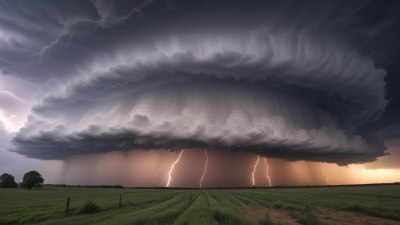How the Sky Influences the Way We Connect With Each Other
Explore how the sky shapes human connection through culture, emotion, and shared experiences across time and space.

Image created with Flux Schnell
The vast expanse above us, the sky, has been a timeless canvas influencing how we interact, communicate, and bond with one another. From ancient civilizations interpreting the stars to modern societies finding solace under a shared blue dome, the sky plays a crucial role in shaping our social connections and collective consciousness.
In an era before technology, the sky was humanity’s first guide and storyteller. People looked upwards not only for navigation but also to understand the world around them. The celestial bodies - sun, moon, planets, and stars - became symbols embedded in myths and rituals that united communities. These narratives, often orally passed down, strengthened the ties within groups while also bridging generations with shared cosmological beliefs.
Consider the role of constellations in different cultures. For the ancient Greeks, constellations such as Orion and Cassiopeia inspired legends that reinforced moral lessons and communal values. Similarly, Indigenous Australians used the arrangement of stars to guide seasonal activities and social ceremonies. Such celestial mappings fostered a profound connection among community members, anchoring their social fabric to the sky’s imagery.
Moreover, the cyclical movements of the sun and moon established calendars governing agricultural cycles and festivals. These temporal markers created rhythms that orchestrated social gatherings, harvest celebrations, and spiritual observances. The communal participation in these events fostered solidarity and mutual reliance among people, essential for survival in early societies.
Beyond practical uses, the sky profoundly influences human emotions and moods, which, in turn, affect interpersonal interactions. Bright, clear skies are often associated with positive moods and openness, facilitating more amiable and cooperative social environments. This phenomenon can be observed even today when group activities are planned around sunny weather or moonlit nights to enhance bonding experiences.
Nighttime, illuminated by the gentle glow of the moon and stars, engenders a sense of wonder and introspection. This shared experience of awe can break down individual barriers, activating empathy and fostering deeper connections. Stargazing, for example, is a universally accessible activity that invites conversation about existence, dreams, and the universe’s mysteries, nurturing a collective sense of belonging.
The sky’s influence on human connection extends to artistic expression. Poets, painters, and musicians across cultures have drawn inspiration from celestial phenomena to explore themes of love, hope, separation, and unity. These creative works become conduits for emotional expression and dialogue, weaving interpersonal ties through shared appreciation of beauty and meaning.
In contemporary urban life, where natural environments are often overshadowed by built structures, the sky remains a daily reminder of our link to the natural world and to each other. Public spaces such as parks and rooftops become venues where people gather to watch sunsets, fireworks, or meteor showers, creating communal moments that counterbalance the isolation sometimes inherent in modern living.
Technology has also transformed how we connect under the sky. Live-streamed astronomical events, social media sharing of celestial photos, and virtual reality space explorations have expanded the communal experience of the sky beyond geographic limitations. These innovations foster global communities bound by a collective fascination with the cosmos, transcending cultural and physical divides.
Furthermore, the shared concern over environmental issues such as light pollution and climate change reflects a collective recognition that the sky is a common heritage needing protection. Grassroots movements and international cooperation remind us that our connection beneath the sky includes a responsibility toward preserving its beauty and accessibility for future generations.
Astrological traditions across cultures, whether ancient or modern, demonstrate another dimension of how the sky influences interpersonal relationships. While the scientific validity of astrology remains debated, its social function as a tool for self-reflection and social interaction is undeniable. Discussing horoscopes and charting personality traits have become popular ways for individuals to understand themselves and others, facilitating conversation and connection.
The psychological impact of the sky on human well-being also indirectly shapes social dynamics. Access to natural light regulates circadian rhythms, influences sleep quality, and affects mental health, all crucial factors in maintaining healthy relationships. Poor weather conditions or prolonged cloud cover can lead to mood disturbances like seasonal affective disorder, which may alter social behaviors and engagement.
On a more spiritual level, the sky often symbolizes transcendence, freedom, and hope, concepts that underpin many religious and philosophical systems. Collective rituals performed under open skies, such as prayers, meditation, or celebrations, create shared experiences that reinforce community identity and mutual support networks.
The sky also serves as a metaphor for connection, often represented in literature and everyday language. Phrases like "under the same sky" emphasize unity despite distance or difference, reminding individuals of their shared humanity and encouraging empathy across divides.
In education, outdoor learning that emphasizes observation of the sky can foster collaboration among students and teachers by encouraging curiosity and joint inquiry. Such experiences not only deepen knowledge but also nurture social skills and a sense of community through shared discovery.
The symbolism of the sky, from its endless horizon to its shifting colors, resonates deeply with human aspirations and relationships. It encourages openness, broad perspectives, and the recognition of our place within larger systems - whether familial, societal, or planetary.
In sum, the sky profoundly shapes how we connect with each other across multiple dimensions: culturally through shared stories and traditions, emotionally by influencing mood and empathy, socially by facilitating gatherings and communication, and spiritually by offering symbols of unity and hope. Recognizing and honoring this influence enriches our appreciation of both the cosmos above and the connections it inspires below.











